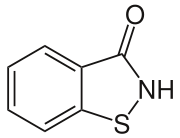Benzisothiazolinone
 | |
| Names | |
|---|---|
| IUPAC name
1,2-benzisothiazol-3(2H)-one | |
| Other names
Benzisothiazolinone, Benzisothiazolin-3-one, Benzisothiazolone | |
| Identifiers | |
| Abbreviations | BIT |
| 2634-33-5 | |
| ChEBI | CHEBI:167099 |
| ChEMBL | ChEMBL297304 |
| ChemSpider | 16567 |
| |
| Jmol-3D images | Image |
| MeSH | 1,2-benzisothiazoline-3-one |
| PubChem | 17520 |
| |
| Properties | |
| Molecular formula |
C7H5NOS |
| Molar mass | 151.19 g·mol−1 |
| Appearance | white powder |
| Melting point | 158 °C (316 °F; 431 K)[1] |
| 1 g/l | |
| Hazards | |
| Main hazards | Xn, N [1] |
| R-phrases | R22, R38, R41, R43, R50 [1] |
| S-phrases | (S2), S24, S26, S37/39, S61 [1] |
| Except where noted otherwise, data is given for materials in their standard state (at 25 °C (77 °F), 100 kPa) | |
| | |
| Infobox references | |
Benzisothiazolinone (BIT) is a widely used biocide and belongs to the group of isothiazolinones.
Usage
Benzisothiazolinone has a microbicide and a fungicide mode of action. It is widely used as a preservative, for example in:
- emulsion paints, caulks, varnishes, adhesives, inks, and photographic processing solutions
- home cleaning and car care products; laundry detergents, stain removers and fabric softeners;
- industrial settings, for example in textile spin-finish solutions, leather processing solutions, preservation of fresh animal hides and skins
- agriculture in pesticide formulations
- gas and oil drilling in muds and packer fluids preservation.[2]:iv
In paints, it is commonly used as a mixture with methylisothiazolinone. Typical concentrations in products are 200–400 ppm depending on the application area and the combination with other biocides. According to a study in Switzerland, 19% of the paints, varnishes and coatings contained BIT in 2000. The fraction in adhesives, sealants, plasters and fillers was 25%. [3]
Health hazards
It is a known human immune system toxicant, and also is classified as irritant for skin, eyes and lungs.[4] It is widely used as active ingredient of many home cleaning products.
References
- ↑ 1.0 1.1 1.2 1.3 Record of 1,2-Benzisothiazol-3(2H)-one in the GESTIS Substance Database of the IFA, accessed on 22 October 2007
- ↑ US EPA. September 29, 2005 EPA Reregistration Decision
- ↑ Reinhard et al.: "Preservation of products with MCI/MI in Switzerland". Contact Dermatitis. 2001 Nov;45(5):257-64. PMID 11722483
- ↑ EWG's Skin Deep Cosmetics Database
Literature
- Wilfried Paulus: Directory of Microbicides for the Protection of Materials and Processes. Springer Netherland, Berlin 2006, ISBN 1-4020-4861-0.